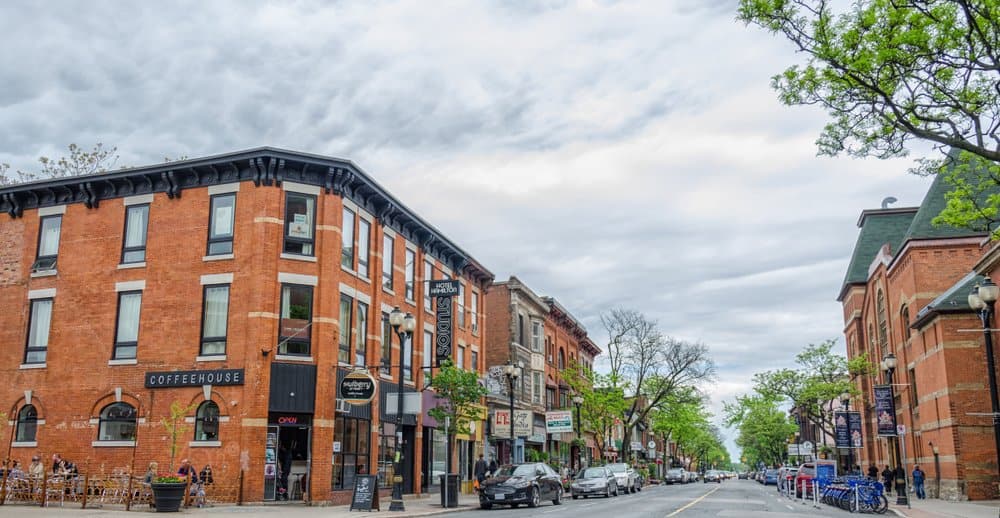Turning Hamilton’s vacant offices into prosperous creative co-working spaces
Published March 17, 2023 at 3:14 pm

Much has been made about office space vacancies. The pandemic spurned a work-from-home revolution of sorts, and the hybrid model implemented by many companies has led to office downsizing, leaving property owners with major voids left untenanted and municipalities concerned about the economic implications of those business black holes.
In Hamilton, Jackson Square has particularly struggled to entice and maintain tenants. And it was a challenge long before COVID-19. Not only has the mall failed to find enough suitors for its retail spaces but for its once-bustling upstairs office spaces, as well.
In the same way they helped fill the void left by the city’s fleeting industrial scene, Hamilton’s community of creatives have stepped in, and they’ve forced us to re-think how private and public spaces can be used. A de-gentrification, if you will.
Artists have been kicked out of their rental spaces for decades. Now, they’re reclaiming them.
Dope Chief Studios is the newest co-working space in Hamilton. The brainchild of rapidly ascending local artist Richard Magarin (aka Dope Chief), the incubator is located on the second floor at Jackson Square, above the farmers market and beside Liaison College. It’s a space available for rent by all types of creatives — both visual and digital, including graphic and web designers, photographers, and videographers. (We’ll get to the latter examples later.)

Psychedelic smurf by Chief Dope
Born and raised in Hamilton’s gritty creative hub on James St. North, Magarin’s work can be seen all over the city. Whether it be a small painting displayed inside a trendy cafe or a mural enveloping the side of a large building, you’ve probably been mesmerized by his trademark vibrancy without even realizing it.
The influence of a city’s creative community is rarely discussed during elections and municipal budget meetings (although it’s certainly discussed more now), in large part because its positive impacts are often unconscious and subjective. But if you’ve ever wondered why your day has suddenly become brighter or you’ve been inexplicably moved to tears, you may want to pay close attention to your surroundings and which of your senses are being tickled. Even Darwin had difficulty making sense of why humans dedicate most of their lives trying to simply “feel” things, but it’s in our nature, and it offers fulfillment.
So while we can’t always articulate the reasons why, every thriving municipality needs a fearless creative community that feels supported — by local bureaucracies to a degree, but especially by its cohorts. Competition breeds excellence, but empathic support ensures a safe launching pad for a delicate industry. This is why creative co-working spaces are so invaluable.

James St. North, with its grit and resiliency, has become synonymous with Hamilton’s art scene. (Tourism Hamilton photo)
The economic impacts of a thriving creative community can, again, be difficult to interpret because of the industries’ inherently subjective and indirect nature. But what often gets overlooked when using “art” ambiguously is that it’s more than just paintings, theatre, and music. Web and app design, movie production, and digital media conglomerates — all hatched from the minds of one or several creatives inspired by those before them.
But by all accounts, the economic impacts are overwhelmingly — and sometimes surprisingly — positive.
A comprehensive American study from 2019 by the Arts and Cultural Production Satellite Account (ACPSA) found that the production of arts and cultural goods and services added 4.3 percent directly to the nation’s gross domestic product (GDP) for a total of nearly $919.7 billion. That’s more than the value added by such industries as construction, transportation and warehousing, mining, and agriculture.
“Investment in the arts and cultural resources can benefit local and state economies by supporting job growth, stimulating commerce and sustaining neighborhoods by stabilizing property values,” according to a report by the University of Pennsylvania.
“The benefits are especially great in communities that don’t have highly visible art identities but do contain rich cultural resources.”
You’d be hard-pressed to find a more resilient group than those driven by their creative passions — fortunate for us, considering the art community has been consistently underappreciated, underfunded, and often overlooked. Nothing motivates fearless creativity quite like an oppressive or underestimating establishment. Thanks to spaces like Dope Chief Studios, that creativity can be harnessed and maximized.
So while it’s unlikely that developers and property managers envisioned their office spaces being decorated with anything but grey cubicles and corner water coolers, the creative conversion is a win for all that only adds to Hamilton’s prosperity.
